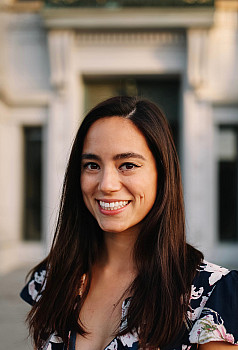Uncovering the Hidden Toll of Natural Disasters
Rachel Young BA ’11 recently published groundbreaking research in the journal Nature on the long-term health impact of tropical cyclones. The article is part of her growing scholarship on the quantifiable social effects of climate change and natural hazards.
Climate Justice

The 2024 Atlantic hurricane season was one of the most dangerous on record, with more than 150 people dying from direct causes in the U.S. and millions affected by severe flooding and high winds. New research from Rachel M. Young BA ’11, published in the top science journal Nature, shows that the long-term impact of tropical storms is far greater than the number of deaths released in the initial aftermath, marking a significant development in the field. This is Young’s latest publication on the social outcomes of environmental phenomena, which is her focus area as a Ciriacy-Wantrup Postdoctoral Fellow at the University of California at Berkeley.

The findings of the article, which was published after Hurricane Helene made landfall in the American Southeast and before Hurricane Milton hit the coast of Florida less than two weeks later, have made waves across the field. The study is the first to look at the impact of storms in the long period that follows immediate devastation, generating media coverage in The New York Times, The Wall Street Journal, and The Washington Post, among other national outlets.
For Young, a Minnesota native who earned her bachelor’s degree in environmental studies at Lewis & Clark, the fight against climate change has been a lifelong passion. During the opening convocation at New Student Orientation, she was struck by former Professor of Economics Eban Goodstein’s address in which he encouraged the incoming class to think about the international consequences of global warming.
Her time at Lewis & Clark, which included running the Students Engaged in Eco-Defense (SEED) club, was formative in her development as a researcher. She was a member of the first-ever cohort of Associate Professor of Geological Science Elizabeth Safran’s (Un)Natural Disasters course, along with several classes with Professor of Environmental Studies James Proctor and Associate Professor of Economics Clifford Bekar, whom she credits with her introduction to the use of fossil fuels in global industrialization.

After graduating, she spent three years working at an environmental think tank in Washington, D.C., before earning her master’s degree in public policy from Berkeley’s Goldman School of Public Policy and her PhD from Princeton’s School of Public and International Affairs. In 2022, Young worked for the White House Council on Environmental Quality, where she helped create guidance for the Federal Flood Risk Management Standard and the climate resilience requirements for the Infrastructure Investment and Jobs Act spending.
Now, in addition to her work at Berkeley, Young serves as a visiting postdoctoral scholar at Stanford’s Global Policy Lab and a postdoctoral researcher with the U.S. Department of Housing and Urban Development, Policy Development and Research. She has another paper in the works about the ways in which storms drive people to move out of high-risk locations, with the preliminary finding that mobility is dependent on the severity of the storm.
“Prior research studying programs that help people relocate after a disaster have focused on buildings rather than the people themselves. My research is focusing on what happens to people and families. Where are they going? Are they better off?” Young asks. “Households are not fully recovering, in part because our attention turns away from disaster victims shortly after the storms make landfall. Our findings shed light on the fact that these communities need sustained support much longer than we previously thought.”
More Stories

New Leadership
Welcoming the New Dean of Lewis & Clark Law School
On January 2, 2025, Alicia Ouellette took the helm as the Jordan D. Schnitzer Dean of Lewis & Clark Law School. “Dean Ouellette’s expertise and visionary leadership are exactly what is needed to build on the law school’s success and lead it into the future,” said Robin Holmes-Sullivan, president of Lewis & Clark.

Student Success
Scholarship Inspires Student to “Fan the Flames of Tribal Sovereignty”
Vincent Montanic Sheoships is this year’s Nelson D. Terry Scholarship recipient. “I am close to achieving my dream of becoming a practicing attorney, and I look forward to fanning the flames of Tribal sovereignty through upholding federal laws that make Tribes distinct and unique.”

Place-Based Learning
From Trash to Treasure: Creating Art From Waste
Cara Tomlinson’s Art and Ecology class uses waste materials from around Portland to create beautiful and meaningful works of art. This course offers a fresh approach to creative practice, merging art and ecology to help students respond to the climate crisis, explore the agency of materials, and build connections to place.

Belonging and Connection
First-Year Experience Positions Students for Success
Transitioning into college can be an emotional, busy time for students and their families. Lewis & Clark’s First-Year Experience team aims to create a smooth transition by laying the groundwork for a successful first semester.
